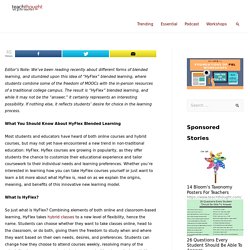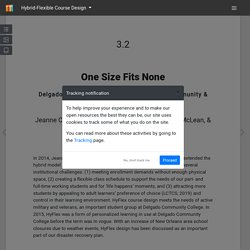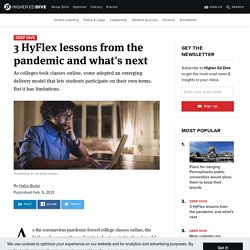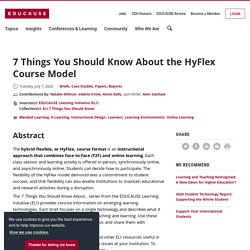

HyFlex Modality - Dr. Vickie S. Cook, Executive Director, Online, Professional & Engaged Learning. What You Should Know About HyFlex Blended Learning. Editor’s Note: We’ve been reading recently about different forms of blended learning, and stumbled upon this idea of “HyFlex” blended learning, where students combine some of the freedom of MOOCs with the in-person resources of a traditional college campus.

The result is “HyFlex” blended learning, and while it may not be the “answer,” it certainly represents an interesting possibility. If nothing else, it reflects students’ desire for choice in the learning process. What You Should Know About HyFlex Blended Learning Most students and educators have heard of both online courses and hybrid courses, but may not yet have encountered a new trend in non-traditional education: HyFlex. Hyflex courses are growing in popularity, as they offer students the chance to customize their educational experience and tailor coursework to their individual needs and learning preferences. One Size Fits None - Hybrid-Flexible Course Design. Jeanne C.

Samuel, Amanda H. Rosenzweig, Mark McLean, & René Cintrón In 2014, Jeanne Samuel discovered a model for delivering courses that extended the hybrid model already in use at Delgado. The new model, HyFlex, solved several institutional challenges: (1) meeting enrollment demands without enough physical space, (2) creating a flexible class schedule to support the needs of our part- and full-time working students and for ‘life happens’ moments, and (3) attracting more students by appealing to adult learners’ preference of choice (LCTCS, 2019) and control in their learning environment.
HyFlex course design meets the needs of active military and veterans, an important student group at Delgado Community College. Institutional Goals for HyFlex Flexibility to Serve the Needs of Growing Demographic By Fall 2018, 68% of our student population was female, the average age of our students continues to rise. Serving More Students Table 1 Room Capacity by Delivery Mode Improved Student Success Impact. HyFlex Course Design – Example 50-Min & 75-Min Class Sessions.
COVID-19 Planning for Fall 2020: A Closer Look at Hybrid-Flexible Course Design - PhilOnEdTech. Since I have only written guest blog posts, many of you won’t know of my plans to write a modern-day, Gulliver’s Travels-esque satire.

The hero or anti-hero – I haven’t yet decided which – travels time instead of oceans. Namely, he can jump to different possible futures and see the repercussions of present day decisions. How many of us would like that ability right now, as we make decisions about fall 2020? I bring this up because I recently included a brief paragraph about how we should “consider ‘hybrid flexible’ course design to support ‘remote flexible’ courses” in the fall. I then followed up on this idea in “Considering Hybrid (Flexible) Models,” a podcast episode conversation with colleagues Phil Hill and Jeanette Wiseman.
The World (Re)Discovered HyFlex If you’re new to the idea of HyFlex course design, I can explain it by way of comparison. The question today seems to be, is now its time? That one tweet alone got at least 360 likes by the time I started writing this blog post. 3 HyFlex lessons from the pandemic and what's next. As the coronavirus pandemic forced college classes online, the higher ed community was buzzing about an instructional model called HyFlex.

The concept wasn't new. In its truest form, HyFlex, sometimes called hybrid-flexible, calls for courses to be created in a way that gives students complete control over how and when to participate, either in-person or online. A small subset of schools was using this format before the pandemic. But the effect of the health crisis on instruction brought new attention to it, as more schools saw its potential to address the uncertainties affecting course delivery. Many colleges that pursued the approach during the pandemic have come up short of full-on HyFlex, however, online learning experts say. Still, they say, institutions can learn from how HyFlex was used during this period, should they want to make it a bigger part of their offerings going forward.
Pure HyFlex isn't an easy win Get Higher Education news like this in your inbox daily. Joy Honea. 7 Things You Should Know About the HyFlex Course Model. The hybrid flexible, or HyFlex, course format is an instructional approach that combines face-to-face (F2F) and online learning.

Each class session and learning activity is offered in-person, synchronously online, and asynchronously online. Students can decide how to participate. The flexibility of the HyFlex model demonstrates a commitment to student success, and that flexibility can also enable institutions to maintain educational and research activities during a disruption. The 7 Things You Should Know About... series from the EDUCAUSE Learning Initiative (ELI) provides concise information on emerging learning technologies. Each brief focuses on a single technology and describes what it is, where it is going, and why it matters to teaching and learning. In addition to the 7 Things briefs, you may find other ELI resources useful in addressing teaching, learning, and technology issues at your institution. Values and Principles of Hybrid Flexible Course Design Hybrid Flexible Course Design.